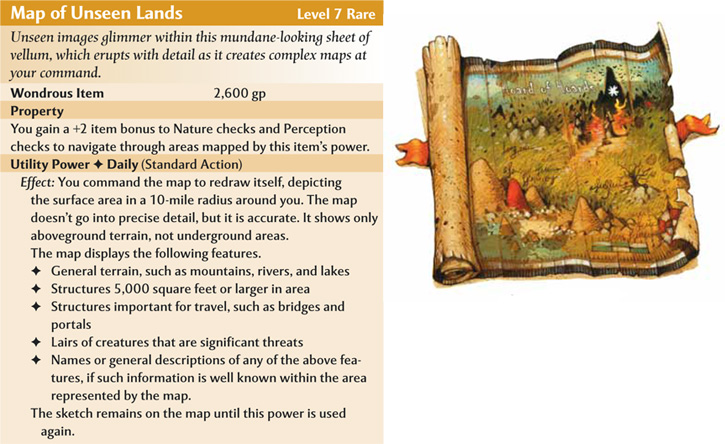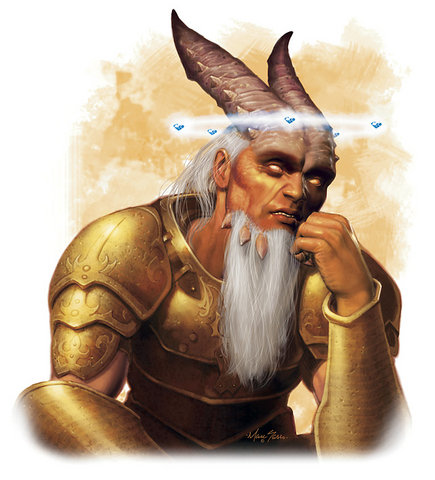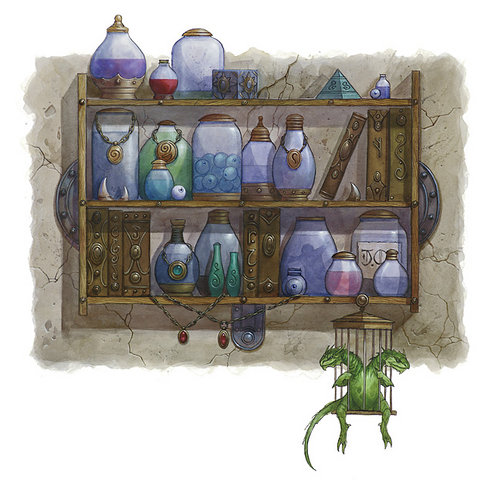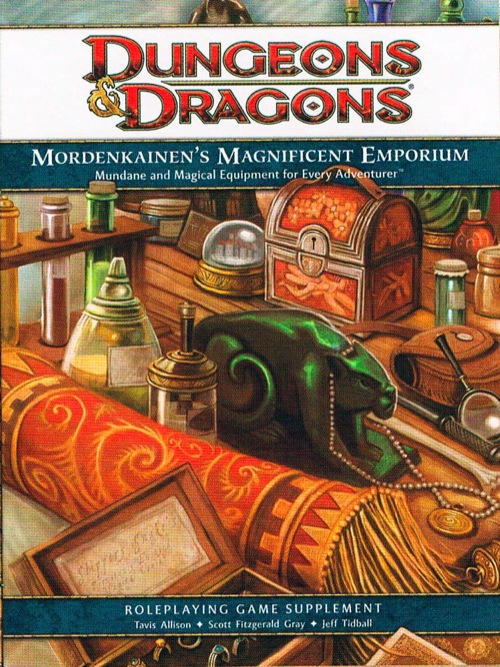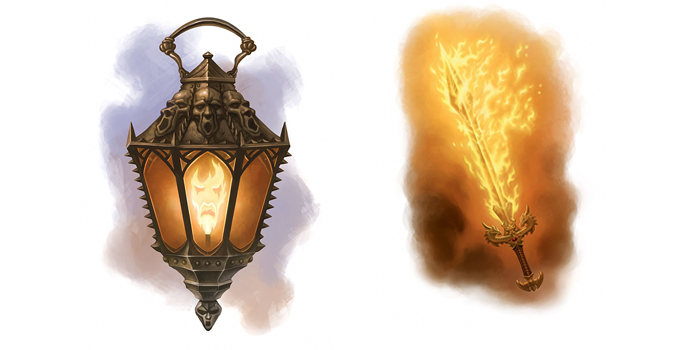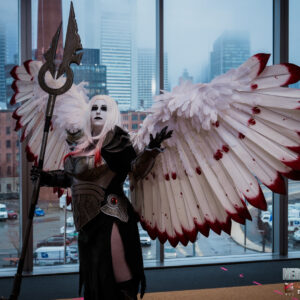A King’s Ransom: Mordenkainen’s Magnificent Emporium
Gamers love magical items. From the humble Ring of Feather Fall to the mighty Holy Avenger, from Sting to the lightsaber (which, let’s face it, is more fantasy than science), magic items have been a part of role-playing since Gygax first picked up a twelve-sider. Each edition of D&D has had it’s book of magical treasure, and now 4th edition has Mordenkainen’s Magnificent Emporium, a slim hardcover that – like a Bag of Holding (or a TARDIS, for you Time Lords) – contains more than seems possible.
The book is presented as the stolen tome of the archmage Mordenkainen and straight away acknowledges the giants on whose shoulders it stands. “Otiluke”, “Bigby”, “Tenser”, and “Evard”: all names sure to bring a nostalgic glow to any old D&D hacks. After this bit of evocative fluff, the introduction settles down a bit and gives some useful advice for using magical items in a the game. The book states that it’s aim is make magical items more magical, a laudable goal at which this book both succeeds and fails. While presented as a resource for both DM and players, DMs (especially new DMs) will find this book very helpful. Players, on the other hand, will find it less useful, possibly even detrimental to their enjoyment, for while it may be used as a idea generator for backgrounds or a wish list, as the book itself suggests, it will also ruin the DM’s surprises if the players peruse it too closely.
Chapters 1 through 4 concern Armor, Weapons, Implements (including staffs and wands), and Magical Gear. After a detailing with a few new mundane armors, weapons, items, and feats to match, the book gets to the good stuff: magical items. We are given over a dozen items in each category including robes, rods, rings, boots, bracers, belts, potions, periapts, pouches, etc. There are old favorites (Ioun Stones, Cloak of the Manta Ray) as well as new treasures (Doppelganger Armor, and the crazy Cloak of the Phoenix). The description of these items – the histories and legends associated with them – are fun, evocative, and inspiring, and the frequent interjection by Mordenkainen display a wicked sense of humor.
Chapter 5 contains artifacts and cursed items. Artifacts, those uber-magic items, as the book states, “break the rules”. They are not simply tools for the PCs but the center of storylines. This chapter gives guidelines for using artifacts, including options for sentient artifacts which posses their own intelligence and pursue their own goal. Over half a dozen artifacts are included from the Book of Infinite Spells to Zax, Cloak of Kings.
After the artifacts are Cursed Items. Here MME breaks with tradition: instead of malevolent items created to be curse upon the PCs, these are normal magic item that have themselves been cursed. The effect on play is much the same, except that the item presented here can have their curses lifted, rendering them useful magic items once again. I have always found cursed items to be a little unfair (DM: “It’s a Ring of Utter Niftiness.” PC: “Capital! I put it on.” DM: “Alas, in truth it is a Ring of Double-Plus Ungoodness. You’re dead.” PC: “@#$%!”), allowing a player to lift the curse from his Sword of the Fallen seems more fun.
The chapter ends with what are called “Story Items”: fantastical items that exist in a game solely to overcome a specific obstacle. Examples include the Blessed Weapon, which is the only way to kill some terrible beasty, and the Talking Object, a sentient and helpful doodad of some kind. None of the 2 dozen story items have any rules associated with them as they operate purely on DM fiat. I found the Story Items to be a bit vague, more like ill-defined artifacts than anything else. Still, the item descriptions are fun and inspiring.
Chapter 6 is entitled “Adventuring Gear” and begins will a practical, if unexciting, look at some mundane items (ball bearings, sacks, cottages, etc) before turning to the more interesting subject of Alchemy. How does alchemy fit into a magic-heavy D&D world? Well, according to MME, it exists to allow any class to create what previous editions called minor (and not so minor) magic items. The Alchemist feat allows the PC to make alchemical items at or below their level. Such items include: Oil of Slipperiness (level 8), Tracking Dust (level 4), and Holy Water (!).
Lastly, the book includes 4 appendices. The first consists of rules for henchmen and hirelings, and includes numerous example of each. Appendix 2 features two random tables to help DMs create interesting descriptions and story hooks to go with their magical items. Appendix 3 introduces the, to my mind, dubious idea of a magic item increasing in power as the character raises in levels. While Appendix 4 is an index of all the items in MME, sorted by level, rarity, and type.
Mordenkainen’s Magnificent Emporium is a pretty book, whose full-color illustrations are both beautiful and evocative. The drawing on page 91 suggests a new way to envision potions and the picture of the adventurer prodding a wall with a 10’ pole has to be one of the best gaming illustrations I’ve ever seen!
I said that MME both succeeds and fails to make magic items more magical. MME succeeds by starting with an item’s story and description and letting the rules follow after. The descriptions are imaginative and intriguing, often providing the DM with ideas and story hooks. The book fails when those rules do not reflect the rich stories and description given for the items. Take, for instance, the Armor of Escape. The description speaks of shrugging of shackles and binding as easily as removing a pair of breeches, yet the items actually grants the wearer a +1 to +5 bonus to escape attempts. Not bad, but far from the automatic success most people enjoy when removing their pants. Or consider the Periapt of Health, which supposedly protects its wearer “against all disease whether inflicted by mundane squalor, the power of magic, or the foulest monster” but according to the rules merely grants a bonus to saving throws against disease, resulting in a non-zero chance that the wearer of the Periapt of Health would contract the plague. Also, the book can sound terribly mundane and banal in places. In the magical gear chapter, for instance, treasures of power and imagination are divided into “Feet Slot Items” and “Neck Slot Items”. OK, yes, I know what they mean but really, ”Neck Slot Items”? It sounds like section 34b of a mannequin-supply company’s catalogue!
But despite these lapses into the prosaic, Mordenkainen’s Magnificent Emporium is a fun and useful book. It’s illustrations, magic item descriptions, and snide comments by Mordenkainen himself, make flipping through the book a really treat. For the novice DM or anyone in search of a little inspiration, Mordenkainen’s Magnificent Emporium is a necessity.

